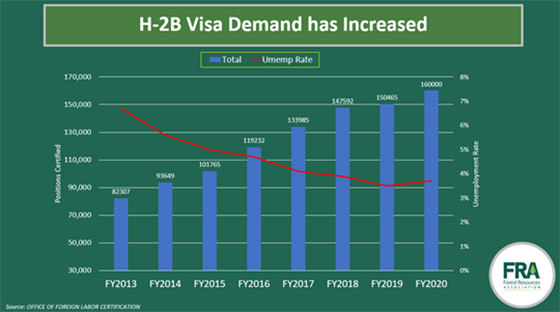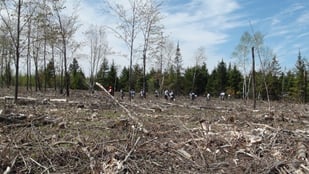H-2B Visas – Will There be Enough Workers Available to Regenerate U.S. Forestlands?

The H-2B visa nonimmigrant program permits employers to hire foreign workers for seasonal employment in the United States. As the second-largest user of H-2B visas, the forest products industry relies on guest workers for seasonal forestry work, such as planting trees and timber stand improvement. Seasonal workers return to their country of origin when their work is completed.
In 1990, Congress set a cap that limits the number of H-2B visas that are available each federal fiscal year. The cap of 66,000 visas is distributed equally in allotments of 33,000 visas on two separate occasions during the fiscal year. The application for the first-half visas begins in July and is for workers with a start date of October 1 to March 31. The second-half visas application process begins on January 1 for employers seeking workers with a start date of April 1 to September 30. If all the first-half visas are not used, they roll over to the second allotment. In recent years, the demand for visas has greatly exceeded the cap creating labor challenges for many seasonal businesses.

Pending Crisis for Forestry on the Horizon?
As demand for H-2B visas grows it will become increasingly more difficult to attain enough workers to meet reforestation demands. Consider that employers of forestry workers apply for 70-80 percent of their workforce during the first-half allotment of H-2B visas. In years past, the availability of visas in this time period was not at issue, as the overall demand for guest workers was less than 33,000.
A couple of notable occurrences have taken place over the last several years, as overall demand for H-2B visas has increased, which suggests a pending crisis is on the horizon for forestry.
The first observation is that the demand for the number of visas for the first half of the FY has increased by 20 percent, since 2015. Additionally, the demand for forestry workers during the first half of the fiscal year has increased by nearly 50 percent from FY2015 to FY2020. This increased demand for first half visas makes it more challenging for employers of forestry workers to attain the seasonal workers needed.
So, what about those 20-30 percent of forest worker employers that seek workers during the second half of the fiscal year? Well, the odds become worse. Since 2015, the demand for second-half visas has increased by nearly 80 percent. The demand by the landscape industry alone is greater than the entire allotment of visas, 66,000, in the H-2B program.
The second notable observation that has occurred over the past several years is that the increased demand for first half visas has resulted in the 33,000 cap being hit sooner than in previous years. In FY2017, the H-2B cap was hit on January 10, 2016. In FY2020 the first-half H-2B visa cap was reached on November 15, 2019. This is eight weeks sooner than in FY2015. Forestry and other seasonal employers who apply for workers during the first half of the fiscal year are experiencing increasing competition for workers every year, competition that they had not experienced just a few years ago.

Congressional Actions
FRA and allies working on the H-2B visa issue have been successful through appropriations language inclusion in FYs 2017, 2018, 2019 and 2020. This language provided authority to the Department of Homeland Security (DHS) to release additional visas when the demand exceeds the cap of 66,000. The administration has responded by allocating supplemental visas in all these years. Most recently, on March 5, the DHS announced that an additional 35,000 visas will be made available for FY2020. This is the largest allocation of supplemental visas to date.
Legislative Outlook
FRA and H-2B allies are working towards a permanent solution to the H-2B cap. Our immediate goal is to include similar language in the FY2021 appropriations language that will provide more authority to the DHS to release additional visas. This language would allow the DHS to release supplemental visas in a timelier manner than in past years.
We will also be seeking a more permanent solution to this issue. Our goal is to have legislation introduced in the 116th Congress that provides a permanent solution to the H-2B visa cap. This legislation would allow for the cap to adjust based on economic indicators, such as the unemployment rate. This type of legislative solution would remove the uncertainty for seasonal employers and assure enough H-2B visas are available to meet demand.
Our Commitment
Regenerating forestlands, whether it’s after a timber harvest or natural disaster, is the cornerstone of forestry and it’s our commitment as an industry, as forestland owners, and as forestland managers. Good forestry manages the forestlands of the present without compromising the needs of the future. The H-2B visa program plays a critical role to help us achieve a very important part of the forest cycle, likely the most important part, planting and re-growing the forest. FRA will continue to focus on a permanent solution that will assure our members that enough seasonal labor is available to meet reforestation demands in the U.S.




